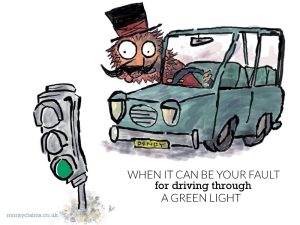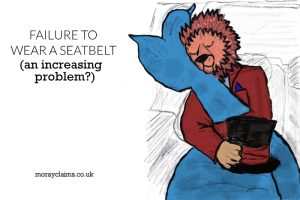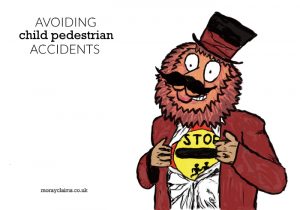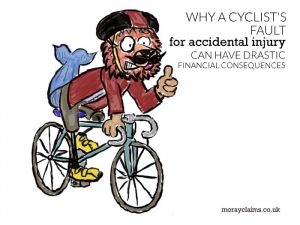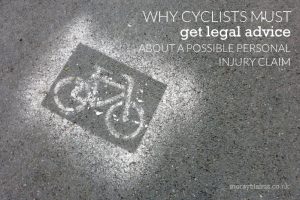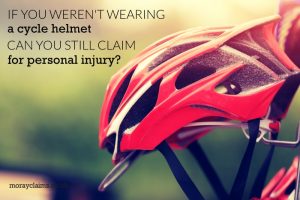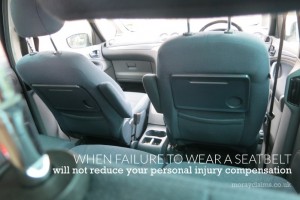You’re in a rush. It’s a dark, wet Monday morning in January. You want to cross the main road on foot at traffic lights, using the pedestrian crossing there; but the lights are green for vehicles - and red for you to cross. On the approach to the traffic lights for vehicles, there are two bus stops. It’s a predominantly residential area. You decide you have to risk crossing on red. Dashing onto the crossing, you suddenly realise an approaching car is bearing down on you. It’s about 5m away and travelling close to the speed limit of 30mph. Your brain freezes with panic. You've misjudged the speed of the oncoming vehicle. You’re rooted to the spot. Paralysed with fear. It's too late to get out of the way. Though the car driver instinctively swerves to avoid you, having only noticed you late, the collision is inevitable. The impact throws you up onto the bonnet. Your head hits the nearside windscreen, causing a “bullseye” break in the glass - i.e. a spider’s web-like Continue Reading
When being even 10 per cent to blame for your own injury is too much
“Can I buy or sell a house without a solicitor?” Grigor & Young have newspaper cuttings books back to the 19th century, and that’s how one cutting from the mid-1980s is headlined. The body text continues: “In theory, you can do much of the work yourself. In theory, you can also remove your own appendix – given a sharp knife, a reliable textbook and a bit of practice.” Seth Godin picked up on this theme of expertise in a post on his daily blog. He asked: “Okay, how hard can it be? (to be an expert). Actually, it might be very hard. Actually, expertise has value. Actually, just because someone said it on the internet doesn’t mean it’s true. Or useful.” What’s the chance you’d be able to do such conveyancing or (especially) surgery yourself? Limited, you would think. Less than 10%? Less than 1%? And a small chance is what you would expect to have, in general, if you were hoping to overturn a finding of 10% contributory negligence in a personal injury Continue Reading
Failing to wear a seatbelt (A problem on the increase?)
The all-time best-selling album of piano music is The Köln Concert by Keith Jarrett. It was recorded at Cologne’s Opera House on 24 January 1975 before an audience of about 1400 people. It’s the best-selling solo album in jazz history (with sales of more than 3.5 million). An astonishing display of improvisational melody and musicianship. Yet it almost did not happen. The piano provided for the late-night performance was sub-standard. Its bass notes were muffled and its high notes tinny. Jarrett himself was suffering from flu. He almost drove off into the night, leaving the first-time, teenage concert promoter, Vera Brandes, to “face the music” of a disappointed and possibly irate public. But he didn’t. Taking pity on Vera – “doing it just for her” – he took a chance and produced one of jazz’s most iconic performances. Risk-taking does not always have good consequences, of course. Failing to wear a seatbelt does not cause a collision but, if a collision occurs, Continue Reading
Avoiding Child Pedestrian Accidents
School crossing patrols stopped in Moray from 20 August 2019. Meaning no more lollipop people to guide our children across the roads. We have to hope that the publicity this controversial Council cutback has received will mean all drivers will take extra special care when in the vicinity of any Moray school. In this article, we will consider 3 matters in relation to pedestrian road traffic accidents involving children. Firstly, we will consider the evidence about road safety measures such as school crossing patrols and why they provide useful benefits. We will then go on to look at the relative duties of drivers and child pedestrians and what scope there is for some of the blame falling on the injured child (contributory negligence). Finally, by means of an example, we will examine the issues that can arise along with contributory negligence, including possible shifting of blame onto a parent who has not taken proper care for their child's safety (in letting them out alone Continue Reading
Why a cyclist’s fault for an accidental injury can have drastic financial consequences
Ned Ryerson must be one of the most beloved “annoying” characters in film history. He is the insurance salesman from Phil Connors’ past who keeps turning up to bug Phil. He appears at the same point on Phil’s walk from his Punxsutawney guesthouse to Gobbler's Knob, as Groundhog Day repeats over and over again. It’s one of my all-time favourite films – one which includes a happy ending for Ned, as he explains: “I have not seen this guy for 20 years but he comes up to me and then he buys whole life, term, uniflex, fire, theft, auto, dental, health – with the optional death and dismemberment plan – water damage… Phil, this is the best day of my life!” The “optional death and dismemberment plan” may be a joke (maybe it isn’t) but the list of so many different types of insurance illustrates that insurance is varied and can be complicated. And while it’s possible to be over-insured, so it’s possible to be under-insured – and under-insurance is one of the things we’ll look at Continue Reading
Why cyclists must get legal advice about a possible personal injury claim
The volume of water that breaks off Antartica as icebergs each year is greater than the total global consumption of freshwater. And icebergs are pure freshwater. Not for the first time, schemes have been proposed to tow icebergs to hot, water-stressed regions of the world. In Spring 2018, for example, before the rains finally came, the four million people in Cape Town, South Africa, came perilously close to ‘Day Zero’ – when they would run out of water. Though the idea of using icebergs in this way originated as long ago as the 19th Century, no plan has ever been put into action. The idea makes even more sense when you think of icebergs otherwise being “wasted” by melting into the salty seas. Of course, another feature of icebergs is that much more of them lie below the waterline than above. Ships need to be aware that initial appearances are deceptive where icebergs are concerned. In this article, we are going to consider why a superficial approach does not work and why Continue Reading
If you were not wearing a cycle helmet can you still claim for personal injury?
The law in the UK does not require pedal cyclists to wear a helmet. What this means is that you won’t be stopped by the police if you fail to wear a cycle helmet. You won’t be prosecuted under the criminal law. On the other hand, Rule 59 of the Highway Code categorises cyclists as vulnerable road users and advises that cyclists ‘should wear a cycle helmet which conforms to current regulations, is the correct size and securely fastened’. The Highway Code is relevant to both criminal and civil law. Claims for personal injury compensation are civil claims for damages, so the Highway Code is relevant. Many cyclists ride without a helmet. Only just over a third of cyclists using major urban roads wore cycle helmets, according to research findings of the UK’s Transport Research Laboratory in 2008. Equivalent research in Germany apparently showed that only 11 % of cyclists in towns and cities wear a cycle helmet. Cycle helmets have to comply with a European standard. This Continue Reading
When not wearing a seatbelt will not reduce your personal injury compensation at all
The modern car seatbelt was invented by a former aviation engineer, whose experience included working on ejector seats. By 1959, cars had seatbelts but only two-point waist restraints. In a car accident, this often did the wearer as much harm as good. Volvo engineer, Nils Bohlin, created a design which anchored the straps low beside the seat. This meant that the geometry of the belts formed a “V” - pointing at the floor – and that the belt would remain in place and not shift under sudden loading. Such a significant advance in driver and passenger safety could have netted Volvo a fortune on the patent. Instead, they gave it away. They decided that the invention was so revolutionary that its value should not profit their company but be a free, life-saving tool. In the world of personal injury claims, if you fail to wear a seat belt and are injured in a road traffic accident, you don’t expect to be free from blame. As we’ve examined elsewhere on this website, UK personal injury Continue Reading
Can You Get 100% Contributory Negligence?
As a chocolate lover, my taste is more for milk chocolate and white chocolate than for dark chocolate. If dark chocolate is married with another flavour, such as mint, I’m a big fan but, on its own, I’ll always prefer the other varieties of chocolate, if I can get them. With 100% dark chocolate, it means that all the ingredients have come from the cocoa bean. 100% dark chocolate is not to everyone’s taste because of its intense bitterness. In the world of personal injury claims, an area where ‘100%’ could leave an intensely bitter taste in your mouth is in relation to contributory negligence. What is contributory negligence? In the usual case, contributory negligence is where it’s accepted by the other party or their insurers that you should get some compensation for your losses. The catch is that they say it was partly due to your own fault that you got injured – so your full compensation should be reduced by a percentage to reflect your share of the blame. In Continue Reading
Pedestrians Hit By Buses On The Pavement
An accident which happened in East Road, Elgin, Moray, has resulted in a Court of Session action for personal injury compensation. The Court of Session is the highest civil court in Scotland. The decision of the court (2015) is a useful illustration of the principles which apply when you have an accident between a bus and a pedestrian who is on the pavement at the time. Elgin bus The injured person, Ian Whyte, was a 10-year-old school boy at the time of the accident in 2008. He claimed against Bluebird Buses Limited for injuries he suffered when a bus struck him as he was standing on the edge of the kerb at the bus stop. Several young people were jostling for position near the kerb, as the bus drew in to the stop. The evidence indicated that the collision was between the near side of the bus, towards the front, and the back of the boy’s head. The impact knocked him over. However, he managed to pick himself up and get home. Much of the evidence in the case was derived from Continue Reading
Jury Trial Risks Highlighted By Dog Bite Case
New Year’s Day in Scotland is a time when families get together to eat, drink and celebrate. Margaret Ferguson went to such a gathering, at her brother-in-law’s house in Dundee, on 01 January 2011. She ended the evening with a serious injury to her face: a full thickness laceration of the left side of her upper lip, extending to and involving the corner of her mouth. Over several months, she went on to need several surgical procedures. The injury left her with permanent scarring. Dog bite The cause of her injury was a bite by her brother-in-law’s Scottish Terrier, Dougal. The dog was nearly 10 years old and suffering from arthritis. As to Dougal’s character, he was “by all accounts, a very friendly good-natured little chap.” So why did he bite Mrs Ferguson? There was a dispute about the circumstances. Mrs Ferguson’s version of events was that, while sitting on the sofa, she had turned round to speak to her husband. At that point, Dougal had suddenly jumped forward and Continue Reading
Pedestrian RTA Claim from Aberdeenshire Illustrates Difficulty of Contributory Negligence
The other day, I got an enquiry from a potential client about a tenancy deposit dispute. Having heard the details, I told him I didn’t think there would be any basis for making a claim. He wanted to continue to discuss the matter, so I had to tell him that I was not going to change my mind and, if he did not accept my advice, he should consider getting a second opinion from another solicitor. At that point, he told me that he had already spoken to several other firms of solicitors in Elgin about the same issue. So, I asked him what advice they had given him. He said: “The same advice that you have given me about it.” I smiled wryly as he said that and the call ended amicably. I had mixed feelings about it. Of course, I would like to feel that possible clients are coming to me with their enquiries as their “first choice” solicitor - which was clearly not the case here. More strongly, though, it struck me as ironic that several solicitors had all apparently Continue Reading
